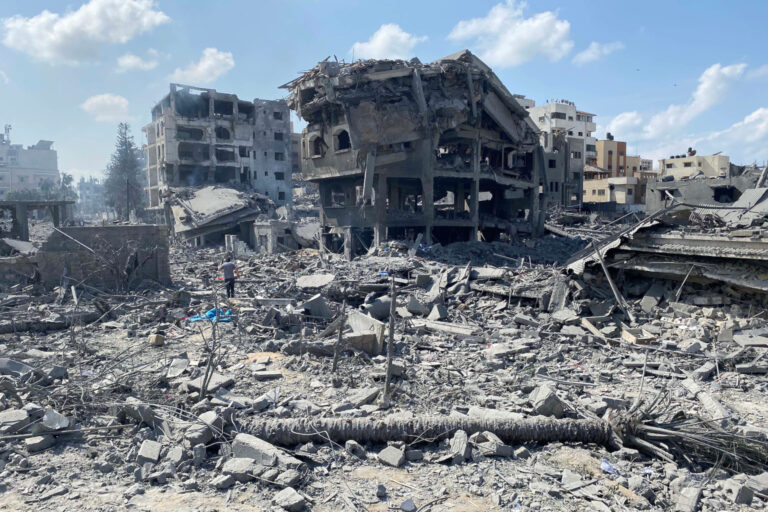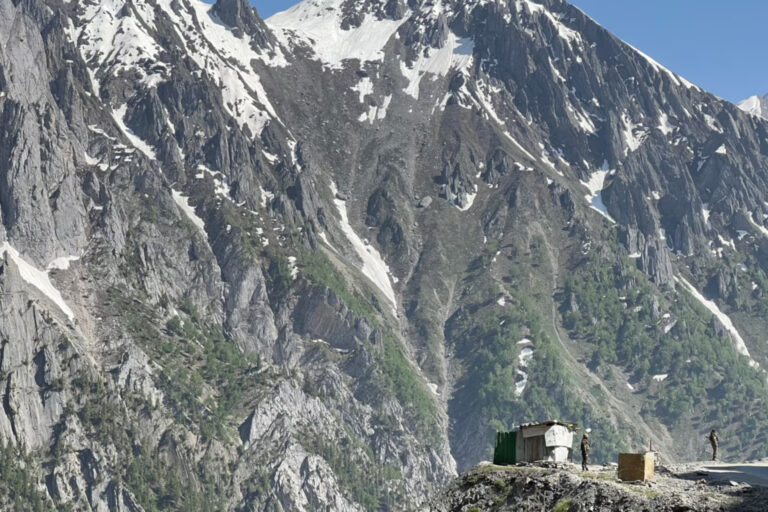Climate change will likely make it harder for people to find potable water. Over the next 50 years, some parts of the planet may become virtually uninhabitable, which could in turn cause large waves of human migration.[1] Nearly a third of the world’s population lives in water-stressed countries, indicating the risk of significant competition for resources, and those with the most access could see their roles in the global economy transform profoundly.[2] Smaller northern countries, like Greenland and Iceland, could become resource-rich as the world turns to them for water.[3] As a result, a new cohort of countries could wind up exposed to the “resource trap”—the notion that easy wealth from natural resources impedes the development of state institutions.[4]
The resource trap paradigm seems a bit weak today. Although cases of overreliance on nonrenewable natural resources stunting institutional and economic maturation exist, analyses tend to focus specifically on countries at risk of succumbing to the resource trap, while overlooking those that are dependent upon extractive resources but have not fallen victim to resource trap characteristics such as oligarchy, autocracy, internal instability, and corruption.[5] While there may not be a preordained “curse to easy riches,” as Sachs and Warner contemplated,” states dependent upon extractives do face an increased risk associated with the resource trap.
Water may not be an extractive resource in the conventional sense, but it shares many of the same characteristics. And over time, as a result of climate change, water scarcity may make it look more and more like the nonrenewable resources of today. Considering where most of the world’s fresh water is found, and the likely effects of climate change, water security is poised to become a serious concern. However, likely before the water-related conflicts forecasted by Makengo et al. manifest, economic security threats related to water may arise.[6]
Resource Trap: Correlation Is Not Causation
The resource trap paradigm can be controversial. Many scholars have offered full-throated support for the belief that overreliance on nonrenewable natural resources can threaten a country’s maturation. Paine, for example, claims that “[i]t is uncontroversial to assert that oil-rich states have weak bureaucratic capacity relative to oil-poor countries with comparable levels of income per capita, a frequently used proxy for state capacity.”[7] Shambaugh and Tayler add that states suffering from the “resource curse” have relatively slower growth rates because of “oligopolistic firms or governments controlling the ‘commanding heights’ of the economy.”[8] Such claims, though, are not reflected in a review of relevant data.
The Extractives Dependency Index (EDI), published by the Extractive Industries Transparency Initiative (EITI), consists of seventy-nine countries reliant on nonrenewable natural resources and measures the extent to which a state depends on underlying commodities extraction and export.[9]
The countries studied by EITI show a wide range of government characteristics, as measured using the World Bank’s World Governance Indicators (WGI): voice and accountability (i.e., voice of the people and accountability of government), political stability, government effectiveness, regulatory quality, rule of law, and control of corruption. While some countries with high aggregate WGI scores do rely on extractives, those most dependent upon extractives struggle with the characteristics measured by WGI. The EDI-scored states with the highest aggregate WGI scores unsurprisingly consist of Norway (585.69), Canada (559.31), Australia (544.23), and the United Kingdom (516.56). At the bottom are Syria (9.14), Yemen (14.91), and Libya (21.16).[10]
Outside the extremes, the relationships between EDI and aggregate WGI are not straightforward. Eight states with EDIs over 60 are in approximately the top third of EDI-measured states by aggregate WGI (Chart 1), including Brunei, which is in the top 10 while showing an EDI of 76.62, immediately followed by Botswana at 62.04 and the United Arab Emirates at 61.08. Of course, the high rankings of Brunei, Botswana, and their peers should be compared to the scores of states not evaluated on EDI, lest this analysis fall into the same myopia trap as the resource trap paradigm. Non-extractive states joining Norway, Canada, Australia, and the United Kingdom with aggregate WGI scores of above 500 are: New Zealand (586.58), Denmark (572.94), Iceland (564.94), Austria (543.74), Germany (531.82), and Japan (530.92).
Chart 1: EITI-Rated Countries by EDI Intensity
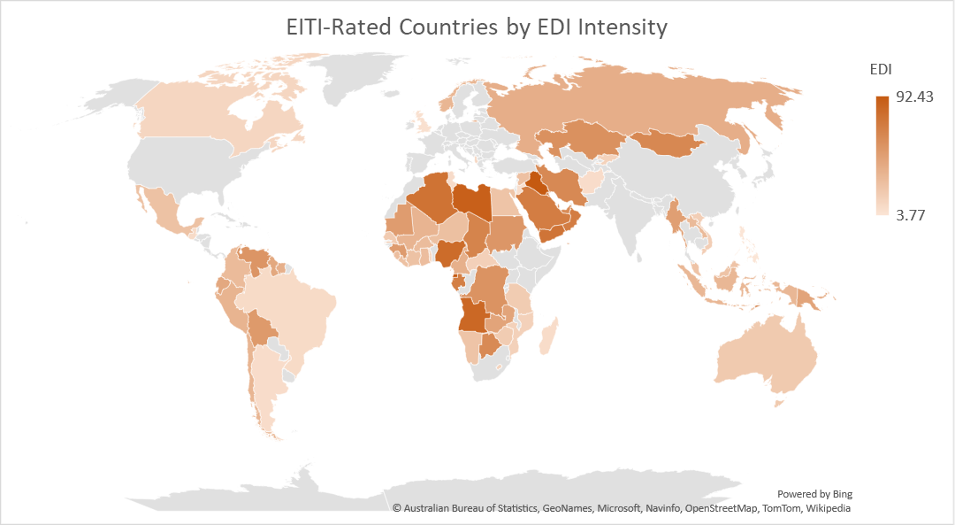
Source: Hailu and Kipgen.[11]
The notion that resource-dependent countries risk falling into the resource trap because resource dependence erodes the quality of institutions would mean significant rates of negative correlation between EDI and each of the WGIs. While correlative relationships are evident (Table 1), their strength varies—and in ways that may seem counterintuitive. For example, one may reasonably assume that impacted institutions would include the legal and regulatory system, which the powers controlling resources could ostensibly manipulate to the benefit of themselves and the surrounding business environment. However, government effectiveness, regulatory quality, rule of law, and control of corruption range in negative correlation from only 16.2 to 22 percent. While values over 20 percent are meaningful, they are still weak relative to the faith some scholars have put in the resource trap paradigm. Further, political stability has the smallest negative correlation to EDI.
Table 1: Correlations between EDI and the various WGIs

Sources: Hailu and Kipgen,[12] World Bank[13]
The most pronounced negative correlation with EDI is voice and accountability, at 41.7 percent. Countries with high EDIs tend to have low voice and accountability measures. Of course, a state can score poorly on voice and accountability and still have a low EDI; Syria has the lowest voice and accountability score yet shows a modest EDI of only 27.32. After Syria, though, fourteen of the next twenty countries have EDIs of above 50 (Chart 2). Moving toward the middle of the EDI list brings less correlation and more ambiguity. Of the bottom half by voice and accountability, only twenty-five have EDIs above 50, some barely so. As a result, voice and accountability strength is a useful indicator of resource trap risk.
Chart 2: EITI-Evaluated Countries by WGI Voice and Accountability

Sources: Hailu and Kipgen,[14] World Bank.[15]
The resource trap is more aptly described as a risk, rather than the “curse” declared by the likes of Sachs and Warner.[16] While some states may be vulnerable to resource trap risk, those with stronger and more open institutions seem poised to resist it. The role of strong liberal democratic institutions, as implied by WGI voice and accountability scores, could become crucial to preventing water-rich countries from falling into the resource trap over the next 50 years. However, there is the risk that the small sizes of the most water-rich nations could leave them overwhelmed by a host of market and geopolitical factors that could impair existing institutions, with economic security particularly threatened by the need to rapidly develop infrastructure and expand institutions to help the global market adapt to changes in supply and resource availability. Similar situations have occurred with other natural resources—particularly extractives—as evidenced by the stunted development of Kazakhstan.[17]
Water: The Next Trapped Resource
Water is a basic human need, is always in demand, and must serve a continually increasing population around the world. Reduced access to water, exacerbated by climate change, could lead to widespread societal consequences, including the threat of armed conflicts and other physical security risks.[18] Indicators of the looming threat already exist; 2.3 billion people live in water-stressed countries, with 733 million in “high and critically water-stressed countries,” according to the United Nations.[19] And while water covers 71 percent of the Earth’s surface,[20] less than 1 percent of it is “both fresh and liquid,” according to Makengo et al, who add that most fresh water (68 percent) is stored in icecaps.
The prospect of water-related conflict represents a worst-case scenario for access to the resource, particularly when considered with a wide range of attendant water security issues, such as the pollution from upstream sources and the restriction of waterflow to neighboring countries. However, economic security threats can arise rapidly and have significant short-term impact. In fact, economic security could be a crucial factor in preventing resource trap risk from manifesting in future water exporting states.
The twenty countries with the most renewable drinking water show the potential for future volatility in access to the commodity, with several exposed to resource trap risk. While the average WGI voice and accountability score for the cohort is fairly robust at 63.2, the range among them stretches from Norway’s 100 down to the Republic of the Congo’s 13.53. Half have voice and accountability scores below the cohort’s average, with three more at or near it. The fact that the top two countries by renewable drinking water stores also have voice and accountability scores above 90 is quite encouraging. The second-ranked country (Iceland) has roughly the supply of the third and fourth countries combined (Guyana and Suriname). The top country, Greenland, has more than five times the renewable drinking water of the rest of the top twenty combined.
While the concentration of renewable drinking water in Greenland and Iceland may offer reason for optimism, they also highlight an interrelated pair of resource trap risk indicators – their population sizes and adoption of their currencies. Because Greenland relies on the Danish Krone, a major increase in economic activity could leave Greenland (and Denmark) exposed to “Dutch Disease,” which is the increase in relative value of a country’s currency, largely due to increasing revenue inflows paired with underinvestment in (or neglect of) other sectors of the economy.[21] Any inflows could contribute to Dutch Disease, but it is most commonly associated with natural resource exports. Essentially, a resource-rich country extracts and exports, which causes other countries to import and spend. Meanwhile, the focus on extractives could come at the expense of other industries, such as agriculture or manufacturing. The resulting increased relative value of the exporting country’s currency makes imports more expensive, which means that extractives wealth is offset by an increase in the cost of imported manufactured goods, food products, or other imports. Iceland, with its own currency and a small population, has significant Dutch Disease vulnerability, as well.
Further, both countries lack the infrastructure and institutions to deal with the strain involved in becoming a globally significant commodity exporter. Of the top twenty renewable water-rich countries, nine have populations below 1 million, with another three under 5 million, and another four under 10 million (Table 2). Small countries, many with their own currencies, and mid-range voice and accountability scores indicate higher resource trap risk susceptibility. All of these factors together, in conjunction with the development risks associated with the rapid development of infrastructure from scratch, clearly signal threats to future stability, even for the likes of Greenland and Iceland with high voice and accountability scores.
Table 2: Top 20 Countries by Renewable Drinking Water
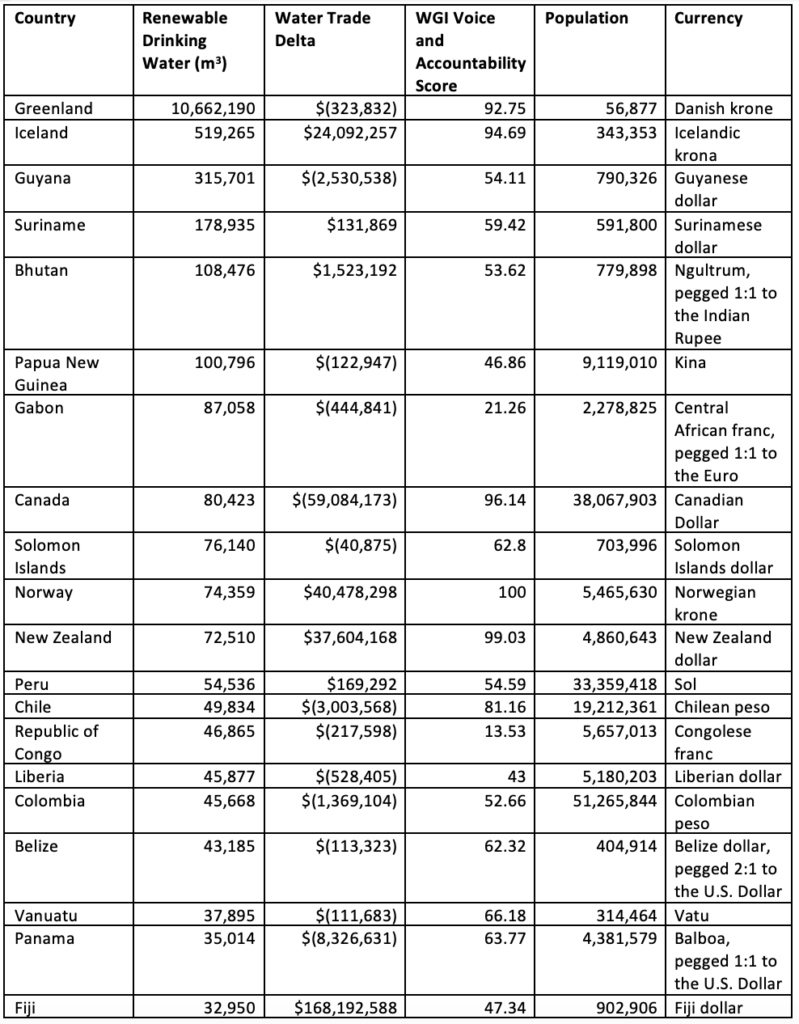
Sources: Central Bank of Belize,[22] IndexMundi,[23] Oanda,[24] OEC,[25] Smith,[26] World Bank,[27] World Population Review.[28]
Canada and Norway show the greatest ability to resist resource trap risk, particularly because they have done so already. Both have EITI-issued EDI scores, indicating a salient reliance on extractives, so they have already navigated resource trap risk exposure. Norway’s potential exposure to Dutch Disease should be noted, given the small population and use of its own currency. Joining Canada and Norway with high voice and accountability scores are New Zealand, Greenland, and Iceland. Greenland’s risks associated with water as a resource are similar to those it could face as it becomes a strategically important source of extractives, with Iceland sharing similar risks, particularly given its size and use of its own currency (without dollarization).
Finally, there is the issue of future supply. Several states with access to large amounts of renewable drinking water still face challenges related to global warming, which could constrain the accessibility and usefulness of their water resources. Of these top twenty countries (Table 3), seven are within approximately 1,000 kilometers of the Equator (including Panama at roughly 1,000 kilometers, with a total of eight if you change the reference point on Peru from Lima to Iquitos). Together, they represent more than 70 million in aggregate population (183 million), topping 100 million with Peru included. The fact these seven countries represent only 755,118 cubic meters of renewable drinking water (with another 54,536 cubic meters from Peru) suggests that a muted global impact, an aggregate population potentially subject to water stress, and other risks related to climate change could exacerbate the conditions that favor the resource trap paradigm.
Table 3: Water-Rich Country Distances to the Equator
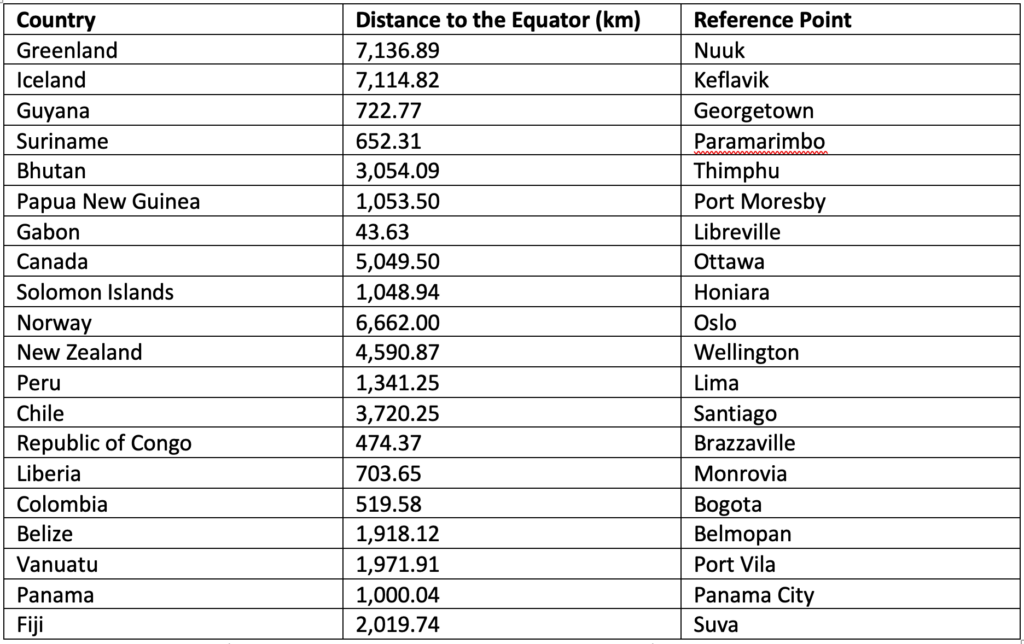
Sources: IndexMundi,[29] World Population Review,[30] Distance.to[31]
Monetary system stability is thus clearly an important risk to manage through the next fifty years of climate change, but there are other significant threats to economic security as well. A large collection of countries with small populations will need to invest considerably in infrastructure in order to support worldwide demand for clean water. In addition to projects focused directly on the resource itself, adjacent industries—from retail and home building to entertainment and healthcare—will need to keep pace with water-related projects. Further, financing those projects and adjacent development may involve considerable risk, given the large amounts of capital that may be necessary to fuel such wide-ranging efforts relative to the small economies that will need the support.
Half a Century for Action
The resource trap risk associated with water availability and security could worsen under the climate change conditions already intensifying it. While the prospect of armed conflict related to clean water access remains a considerable and legitimate concern, economic security will come to bear sooner. Managing the economic security threat, of course, could also serve to at least mitigate the risk of armed conflict, although in isolation it could not prevent conflict completely. The importance of water cannot be overstated; with human life on the line, acute water shortages could lead to aggressive measures. Ultimately, stability will be crucial throughout what could become a rapid and turbulent period of expansion for smaller countries that likely will not be prepared for the extra attention and pressure they could encounter.
The global community may have fifty years until parts of the equatorial region are uninhabitable, at least according to some estimates.[32] The Intergovernmental Panel on Climate Change (IPCC) reports of signs that the next fifty years could be worse than the last fifty—and the last fifty were the worst five decades in the past two thousand years.[33] However, the onset of climate change effects during that period will be uneven. Take Greenland: some amount of Arctic icecap melt will have to occur before some forms of preparation for future industry can even begin, which erodes the fifty years of preparation. If the rate of Arctic melt is curvilinear and accelerates with time, then the earliest years would afford the least opportunity for development, significantly compressing the available time for action, and as a result increasing project and financial risk considerably, causing economic security threats to arise.
Liberal democratic values and respect for the citizenry may be foundational to avoiding the resource trap—and thus mitigating economic security threats—but could become difficult to maintain in the face of significant economic and operational pressures, which issues such as climate migration could exacerbate.[34] Infrastructure and investment challenges could overwhelm nations that otherwise show the values and characteristics that would normally help them mitigate resource trap risk.
Water-rich states facing resource trap risk will benefit from strong relationships with larger and more economically evolved nations, which could provide investment, institutional support, and even access to stable monetary systems. Navigating the resource trap thus might involve trading some amount of sovereignty for stability. While that Faustian bargain may be the necessary survival, perhaps in the end, the states making the trade will find the same redemption Dr. Faust nabbed from Mephistopheles in the end.[35]
[1] Chi Xu et al., “Future of the human climate niche,” Proceedings of the National Academy of Sciences of the United States of America 117, no. 21 (May 2020): 11350-11355, https://www.pnas.org/content/117/21/11350.
[2] UN-Water, Summary Progress Update 2021 – SDG 6 – water and sanitation for all (Geneva, 2021), 7, https://www.unwater.org/app/uploads/2021/12/SDG-6-Summary-Progress-Update-2021_Version-July-2021a.pdf.
[3] “About the Site,” Observatory of Economic Complexity, last accessed January 17, 2022, https://oec.world/en/resources/about.
[4] Ellen Hillbom, “Botswana: Caught in a natural resource trap,” in Natural Resources and Economic Development: Learning from History, eds. Marc Badia-Miro, Vicente Pinilla, and Henry Willebald (London: Routledge, 2015), 78.
[5] For example see United Nations, Transforming Extractive Industries for Sustainable Development (Geneva, 2021).
[6] Benjamin Mwadi Makengo et al., “Water: A Major Stake of Conflicts in the Twenty-First Century,” Open Journal of Social Sciences 9, no. 11 (November 2021): 125–148, https://doi.org/10.4236/jss.2021.911011.
[7] Jack Paine, “Rethinking the Conflict ‘Resource Curse’: How Oil Wealth Prevents Center-Seeking Civil Wars,” International Organization 70, no. 4 (Fall 2016): 735, https://www.jstor.org/stable/44651921.
[8] George Shambaugh and Aaron Tayler, “The Energy Revolution: A Resource Blessing or a Resource Curse?,” Georgetown Journal of International Affairs 16, no. 2 (Summer–Fall 2015): 206–7.
[9] Degol Hailu and Chinpihoi Kipgen, The Extractives Dependence Index (EDI) (New York, 2015), 1.
[10] “World Governance Indicators,” World Bank, last accessed February 23, 2022, http://info.worldbank.org/governance/wgi/.
[11] Hailu and Kipgen, The Extractives, 14–15.
[12] Hailu and Kipgen, The Extractives, 14–15.
[13] World Bank, “World Governance Indicators.”
[14] Hailu and Kipgen, The Extractives, 14–15.
[15] World Bank, “World Governance Indicators.”
[16] Jeffrey D. Sachs and Andrew M. Warner, “Natural Resource Abundance and Economic Growth,” NBER Working Paper Series, no. 5398 (December 1995): 3, https://www.nber.org/system/files/working_papers/w5398/w5398.pdf.
[17] Elena Paltseva and Jasper Roine, “Are Natural Resources Good or Bad for Development?” Free Network, November 21, 2011, https://freepolicybriefs.org/2011/11/21/are-natural-resources-good-or-bad-for-development/.
[18] Makengo et al., “Water.”
[19] UN-Water, 7.
[20] Water Science School, “How Much Water Is There on Earth?” US Geological Survey, November 13, 2019, https://www.usgs.gov/special-topics/water-science-school/science/how-much-water-there-earth.
[21] Frederick van der Ploeg and Steven Poelhekke, “Volatility and the natural resource curse,” Oxford Economic Papers 61, no. 4 (October 2009): 733, https://www.jstor.org/stable/27784157.
[22] “Belize’s Currency,” Central Bank of Belize, last accessed January 26, 2022, https://www.centralbank.org.bz/currency.
[23] “About IndexMundi,” IndexMundi, last accessed January 26, 2022, https://www.indexmundi.com/about.html.
[24] “Online Forex Trading & Forex Broker,” OANDA, last accessed January 26, 2022, http://www.oanda.com.
[25] Observatory of Economic Complexity, “About.”
[26] Elliot Smith, “African currency used by 14 countries could end peg to the euro,” CNBC, December 20, 2019, https://www.cnbc.com/2019/12/20/african-currency-used-by-14-countries-could-end-peg-to-the-euro.html.
[27] World Bank, “World Governance Indicators.”
[28] “Total Population by Country 2022,” World Population Review, last accessed January 17, 2022, https://worldpopulationreview.com/countries/.
[29] IndexMundi, “About.”
[30] World Population Review, “Total Population.”
[31] “Distance Calculator,” Distance.to, last accessed January 23, 2022, https://www.distance.to/.
[32] Sean Fleming, “3 billion people could live in places as hot as the Sahara by 2070 unless we tackle climate change,” World Economic Forum, May 13, 2020, https://www.weforum.org/agenda/2020/05/temperature-climate-change-greenhouse-gas-niche-emissions-hot/.
[33] UN News Staff, “IPCC report: ‘Code red’ for human driven global heating, warns UN chief,” UN News, August 9, 2021, https://news.un.org/en/story/2021/08/1097362.
[34] Xu et al., “Future of the human climate niche.”
[35] Walter A. Kaufmann, “Goethe’s Faith and Faust’s Redemption,” Monatshefte 41, no. 7 (1949): 373.



